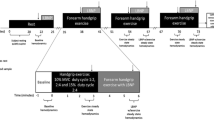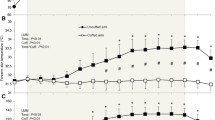Abstract
To determine vasodilatory responsiveness we measured forearm blood flow (FBF) following reactive hyperemia (RH), prior to and following a bout of maximal aerobic exercise in endurance- (n=14) and resistance-trained men (n=10). Both groups were similar in height, body mass, and percentage body fat. Using strain-gauge plethysmography, resting FBF was higher in the resistance-trained group [4.82 (0.84) vs 3.33 (1.17) ml min−1 100 ml−1 of tissue; P<0.05]. However, the resistance-trained group had a 17%–29% lower pre-exercise FBF response to RH for the first 45 s (P<0.05). Following the maximal exercise bout there were no group differences in FBF. Post-exercise FBF was higher compared to pre-exercise values in both the endurance- (P<0.001) and resistance- (P<0.01) trained groups. Endurance-trained men appear to have a greater peak vasodilatory capacity compared to resistance-trained men, and acute maximal exercise increased the vasodilatory capacity in both groups. Acute exercise also equalized the peak vasodilatory response between the endurance- and resistance-trained groups, suggesting the potential for flow-mediated vasodilatation was similar for both groups.


Similar content being viewed by others
References
Alomari MA, Welsch MA, Prisby RD, Lee CM, Wood RH (2001) Modification of forearm vascular function following short-term handgrip exercise training. Int J Sports Med 22:361–365
Bergholm R, Mäkimattila S, Valkonen M, Liu M, Lahdemperä S, Takinen M, Sovijärvi A, Malmberg P, Yki-Järvinen H (1999) Intense physical training decreases circulating antioxidants and endothelium-dependent vasodilatation in vivo. Atherosclerosis 145:341–349
Blair SN, Kohl HW, Paffenbarger RS, Clark DG, Cooper KH, Gibbons LW (1989) Physical fitness and all-cause mortality. JAMA 262:2395–2401
Bruce R (1972) Multi-stage treadmill test of submaximal and maximal exercise. In: Committee on Exercise, Am. Heart Association. Exercise testing and training of apparently healthy individuals: a handbook for physicians. Dallas, Texas, pp 32–34
Cannon RO (1998) Role of nitric oxide in cardiovascular disease: focus on the endothelium. Clin Chem 44:1809–1819
Clarkson P, Montgomery HE, Mullen MJ, Donald AE, Powe AJ, Bull T, Jubb M, World M, Deanfield JE (1999) Exercise training enhances endothelial function in young men. J Am Coll Cardiol 33:1379–1385
Copeland SK, Mills MC, Lerner JL, Crizer MF, Thompson CW, Sullivan JM (1996) Hemodynamic effects of aerobic vs resistance exercise. J Hum Hypertens 10:747–753
DeSouza CA, Shapiro LF, Clevenger CM, Dinenno FA, Monahan KD, Tanaka H, Seals DR (2000) Regular aerobic exercise prevents and restores age-related declines in endothelium-dependent vasodilation in healthy men. Circulation 102:1351–1357
Hambrecht R, Hillbrich L, Erbs S, Gielen S, Fiehn E, Schoene N, Schuler G (2000a) Correction of endothelial dysfunction in chronic heart failure: additional effects of exercise training and oral L-arginine supplementation. J Am Coll Cardiol 35:706–713
Hambrecht R, Wolf A, Gielen S, Linke A, Hofer J, Erbs S, Schoene N, Schuler G (2000b) Effect of exercise on coronary endothelial function in patients with coronary artery disease. N Engl J Med 342:454–460
Heller RF, Chinn S, Tunstall-Pedoe HD, Rose G (1984) How well can we predict coronary artery disease? Findings in the United Kingdom Heart Disease Prevention Project. BMJ 288:1409–1411
Higashi Y, Sasaki S, Sasaki N, Nakagawa K, Ueda T, Yoshimizu A, Kurisu S, Matsuura H, Kajiyama G, Oshima T (1999a) Daily aerobic exercise improves reactive hyperemia in patients with essential hypertension. Hypertension 33 (part II):591–597
Higashi Y, Sasaki S, Kurisu S, Yoshimizu A, Sasaki N, Matsuura H, Kajiyama G, Oshima T (1999b) Regular aerobic exercise augments endothelium-dependent vascular relaxation in normotensive as well as hypertensive subjects: role of endothelium-derived nitric oxide. Circulation 100:1194–1202
Higashi Y, Sasaki S, Matsuura H, Kajiyama G, Oshima T (2001) A noninvasive measurement of reactive hyperemia that can be used to assess resistance artery endothelial functions in humans. Am J Cardiol 87:121–125
Hornig B, Maier V, Drexler H (1996) Physical training improves endothelial function in patients with chronic heart failure. Circulation 93:210–214
Katz SD, Yuen J, Bijou R, LeJemtel TH (1997) Training improves endothelium-dependent vasodilation in resistance vessels of patients with heart failure. J Appl Physiol 82:1488–1492
Kingwell BA, Sherrad B, Jennings GL, Dart AM (1997) Four weeks of cycle training increases basal production of nitric oxide from the forearm. Am J Physiol 272:H1070-H1077
McConnell TR (1988) Practical considerations in the testing of VO2max in runners. Sports Med 5:57–68
Noble BJ, Borg GAV, Jacobs I, Ceci P, Kaiser P (1983) A category ratio perceived exertion scale: relationship to blood and muscle lactates and HR. Med Sci Sports Exerc 15:523–528
Powell KE, Thompson PD, Casperson CJ, Kendrick JS (1987) Physical activity and the incidence of coronary heart disease. Annu Rev Public Health 8:253–287
Vane JR, Änggård EE, Botting RM (1990) Regulatory functions of the vascular endothelium. N Engl J Med 323:27–36
Author information
Authors and Affiliations
Corresponding author
Rights and permissions
About this article
Cite this article
Baynard, T., Miller, W.C. & Fernhall, B. Effects of exercise on vasodilatory capacity in endurance- and resistance-trained men. Eur J Appl Physiol 89, 69–73 (2003). https://doi.org/10.1007/s00421-002-0758-2
Accepted:
Published:
Issue Date:
DOI: https://doi.org/10.1007/s00421-002-0758-2




